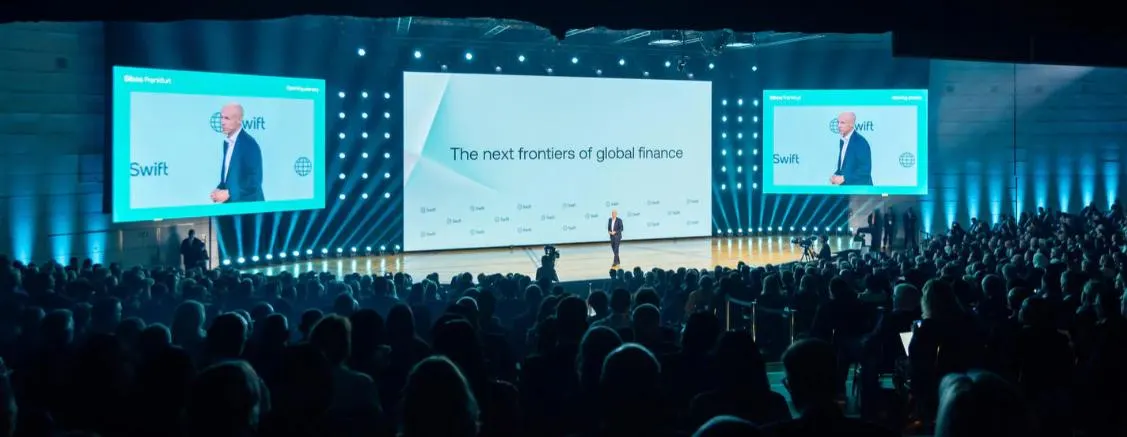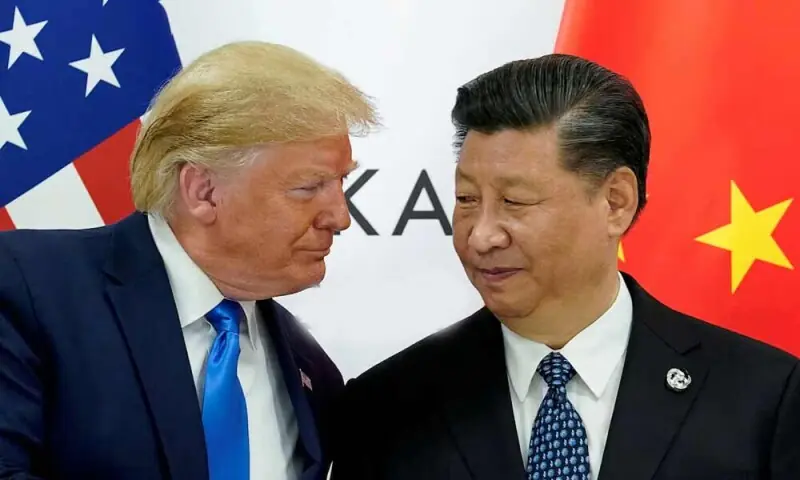By Alexandra Andhov,Contributor
Copyright forbes

On September 29, 2025, at the annual Sibos conference in Frankfurt, a moment occurred that is going to reshape the architecture of global finance fundamentally. Javier Pérez-Tasso, CEO of SWIFT, stood before the assembled leaders of the financial world and announced something that seemed almost unthinkable just a few years earlier:
“We provide powerful and effective rails today and are moving at a rapid pace with our community to create the infrastructure stack of the future. Through this initial ledger concept, we are paving the way for financial institutions to take the payments experience to the next level with SWIFT’s proven and trusted platform at the centre of the industry’s digital transformation.”
SWIFT CEO Javier Perez-Tasso introducing the new blockchain chapter for SWIFT
The Society for Worldwide Interbank Financial Telecommunication, aka SWIFT, the 52-year-old backbone of international banking, would integrate blockchain technology into its core infrastructure. For decades, SWIFT had been the invisible infrastructure connecting 11,500 financial institutions across more than 200 countries and territories. Every cross-border payment, every international wire transfer, every trade settlement—nearly all of them moved through SWIFT’s secure messaging system. It was the circulatory system of global commerce, processing tens of millions of instructions daily.
Now, it is betting its future on distributed ledger technology.
The New Infrastructure for the Financial World
The vision is ambitious: a blockchain-based shared ledger that would enable instant, 24/7 cross-border transactions.
No more waiting days for payments to clear.
No more banking hours.
No more weekends when the financial world ground to a halt.
SWIFT, together with more than 30 financial institutions, will design and build the ledger with a conceptual prototype by Consensys. Financial institutions, including JPMorgan Chase, Bank of America, HSBC, Deutsche Bank, and Emirates NBD, had already joined the initiative to build a prototype designed to handle regulated tokenised value using smart contracts.
MORE FOR YOU
The technical details are promising: real-time transaction recording and validation, interoperability with existing systems, and the ability to move any form of regulated tokenised value across digital ecosystems. But the real revolution is actually strategic—SWIFT has recognised the need for a new infrastructure. What the blockchain industry has been saying for years has finally been heard. There is technology to improve the financial ecosystem.
The timing of SWIFT’s announcement is not accidental. Several converging forces made blockchain integration not just desirable, but necessary:
The Technology has evolved: Distributed ledger technology is not what it used to be a few years ago. The technology has evolved, and so has the industry.
The Always-On Economy: Global commerce no longer respects banking hours. E-commerce platforms operate 24/7. The traditional model of cross-border payments, which took 3-5 business days, had become a bottleneck, and banks recognise the potential of blockchain.
The Stablecoin Challenge: Over the past two years, stablecoins like USDT and USDC had been processing over $1 trillion in monthly transactions, demonstrating that blockchain-based value transfer worked at scale. SWIFT risked becoming irrelevant if it did not adapt.
Regulatory Clarity: The approval of Bitcoin ETFs in the United States, the EU’s MiCA framework, and clearer guidelines in several Asian countries have created the (minimum) regulatory foundations for institutional blockchain adoption.
Competitive Pressure: Newer payment networks and blockchain-based alternatives were beginning to chip away at SWIFT’s dominance. SWIFT recognise that either they will evolve or dissolve.
The Technical Architecture: Building the Future Blockchain
SWIFT’s blockchain ledger represents a sophisticated technical achievement. The system is designed to:
Record and Validate Transactions in Real-Time: Using smart contracts, the ledger will automatically sequence, validate, and enforce rules for every transaction, eliminating the delays inherent in traditional correspondent banking.
Facilitate Tokenised Value: The industry sees tokenisation of financial assets as a real and valuable case study, and therefore also the infrastructure will support any form of regulated tokenised asset—from digital currencies to tokenised securities—enabling a new generation of financial products.
Ensure Interoperability: Perhaps most importantly, the ledger will connect with both existing fiat currency rails and emerging digital networks. Banks will not need to choose between old and new—they can use both.
Maintain Security and Resilience: SWIFT’s reputation was built on rock-solid security. The blockchain implementation will leverage the organisation’s decades of experience in protecting the global financial system from fraud, cyberattacks, and operational failures.
As Pérez-Tasso emphasised: “In infrastructure, strength comes through layered innovation. It’s not either/or, it’s definitely both. And actually, we’re convinced that the whole will be greater than the sum of its parts.”
The Parallel-Track Strategy
One of the most significant aspects of SWIFT’s approach is its commitment to running parallel systems. The blockchain ledger isn’t replacing traditional SWIFT messaging—it’ is augmenting it.
This strategy serves multiple purposes:
Gradual Migration: Banks can adopt blockchain capabilities at their own pace, continuing to use traditional SWIFT services while building expertise in the new system.
Universal Access: Smaller institutions that lack blockchain sophistication will not be left behind. They can continue operating on familiar rails while the industry transitions.
Risk Management: By maintaining existing systems, SWIFT reduces the risk of catastrophic failure if unexpected problems emerge with the blockchain implementation.
Market Testing: The parallel approach allows SWIFT to refine the blockchain ledger based on real-world usage before making it the primary system.
What This Means for Different Stakeholders
For Large Corporations: The promise of instant, always-on cross-border payments means more efficient treasury management, better cash flow visibility, and reduced working capital requirements. Eva Rubio, Head of Global Transaction Banking at BBVA, noted: “The ability to settle regulated value in real time—with the reliability and security that the industry expects from SWIFT—will unlock new efficiencies and opportunities for our clients.”
For Financial Institutions: Banks gain access to new revenue streams through tokenised assets, improved operational efficiency through automation, and the ability to offer 24/7 services that match customer expectations.
For Remittance Recipients: In 2024, global remittance flows surpassed $700 billion, with developing countries receiving over $600 billion. Faster, cheaper cross-border payments could save billions in fees and accelerate economic development.
For Blockchain Companies: SWIFT’s endorsement legitimises blockchain technology at the highest levels of traditional finance, potentially accelerating adoption across other sectors.
The Governance Framework
A critical question surrounding SWIFT’s blockchain ledger is governance: Who decides the rules?
SWIFT has been careful to position itself as an infrastructure provider, not an arbiter of what can move across that infrastructure. “The types of tokens that will be exchanged on the ledger are the territory of commercial and central banks,” the organisation stated firmly.
This approach shows the wish for SWIFT’s neutrality—a key element of its value proposition. The cooperative, currently, does not favour any particular currency, token, or asset class. Instead, it aims to provide a secure and reliable infrastructure that enables trusted value transfer.
However, the 30+ institutions designing the ledger will inevitably influence its standards, protocols, and operational rules. Their decisions will shape how the system functions for years to come, making their geographic and institutional diversity crucial to creating truly global infrastructure.
The Roadmap Ahead
SWIFT’s blockchain journey is just beginning. The organisation has outlined a phased approach:
Phase 1: Complete the conceptual prototype with Consensys and validate core functionality with partner banks.
Phase 2: Expand the pilot program to include more institutions and test additional use cases beyond cross-border payments.
Phase 3: Initiate a gradual rollout to SWIFT’s global community, accompanied by training programs and support for institutions of all sizes.
Phase 4: Achieve full interoperability between the blockchain ledger and traditional SWIFT messaging, creating a seamless hybrid system.
The timeline for full implementation remains deliberately flexible—SWIFT is prioritising getting it right over moving fast.
Broader Implications for Financial Infrastructure
SWIFT’s blockchain announcement represents more than just one organisation’s technology upgrade. It signals a fundamental shift in how the global financial system thinks about infrastructure:
Hybrid Systems Are the Future: The either/or debate between traditional finance and blockchain is over. The future is both, working together.
Standards Matter: SWIFT’s involvement brings institutional rigor, security standards, and interoperability requirements that could benefit the entire blockchain ecosystem.
Adoption Requires Trust: For blockchain to move from niche to mainstream in finance, it needs the endorsement of trusted institutions. SWIFT provides that trust.
Innovation Can Be Methodical: The narrative that incumbents cannot innovate has been challenged. SWIFT demonstrates that established institutions can embrace transformative technology while maintaining stability.
The Road Ahead
As 2025 draws to a close, SWIFT’s blockchain initiative represents both an ending and a beginning. It marks the end of the debate over whether blockchain belongs in mainstream finance—that question has been answered definitively.
It begins a new chapter where the question becomes not whether blockchain will transform global payments, but how that transformation will unfold and who will benefit.
Javier Pérez-Tasso’s vision of “the infrastructure stack of the future” is no longer abstract.
The silent revolution has become audible. And it will be felt in every corner of the global financial system for decades to come.
Editorial StandardsReprints & Permissions



